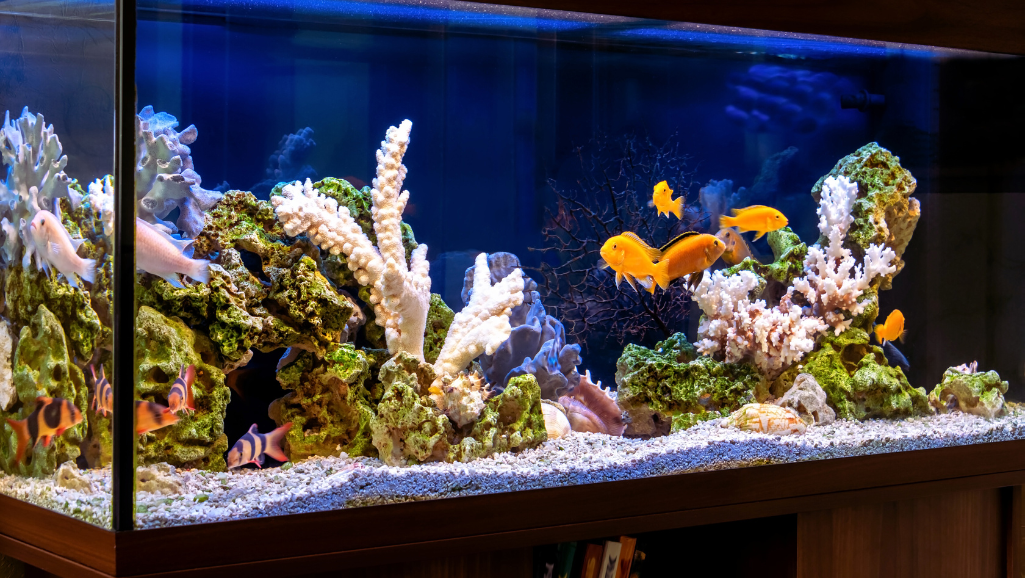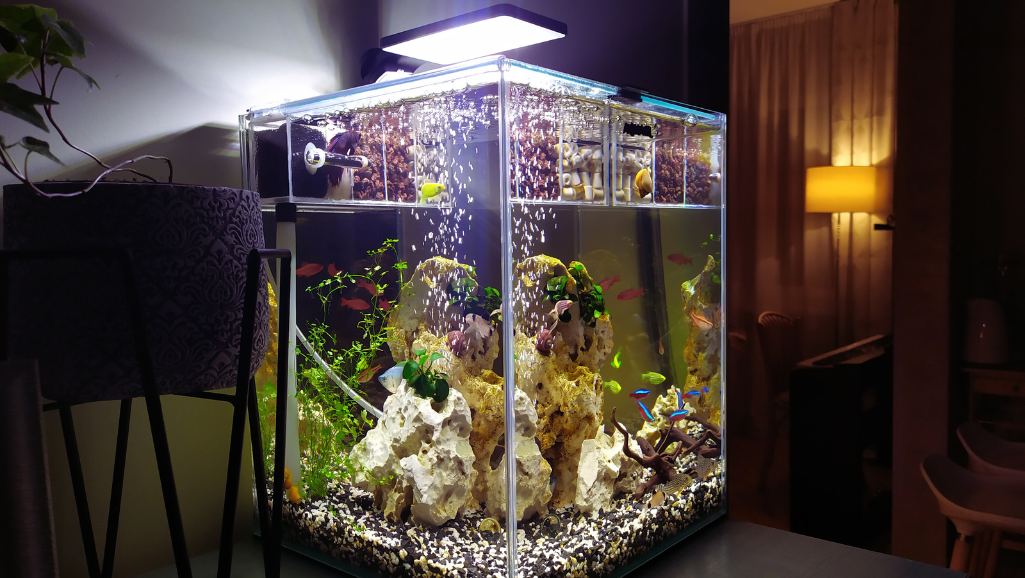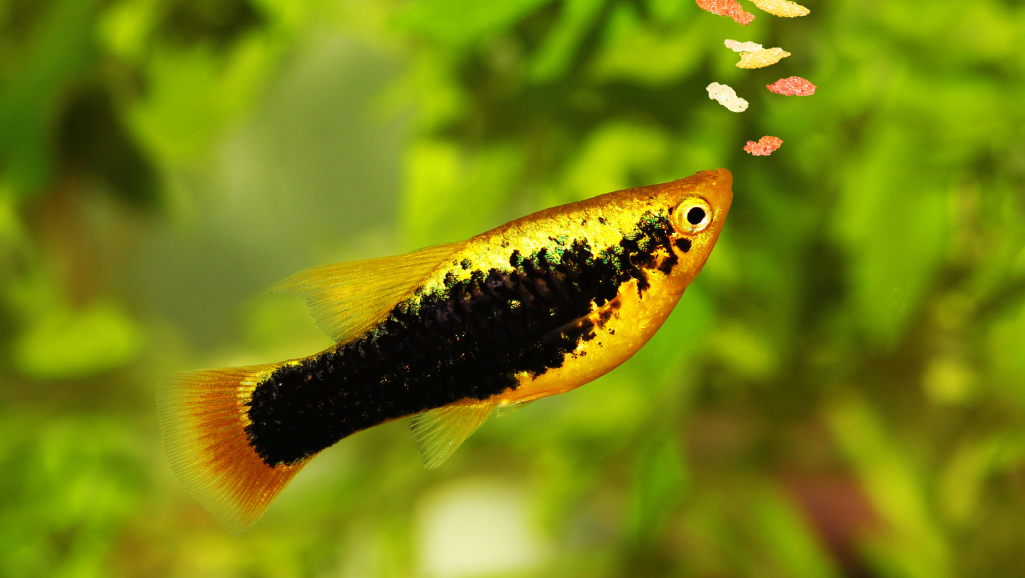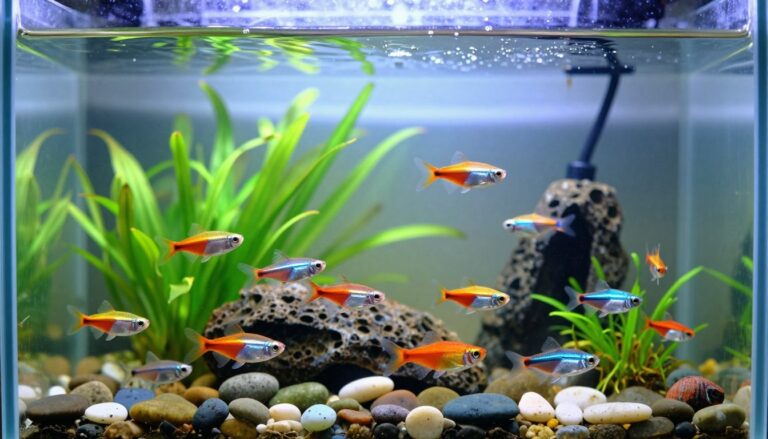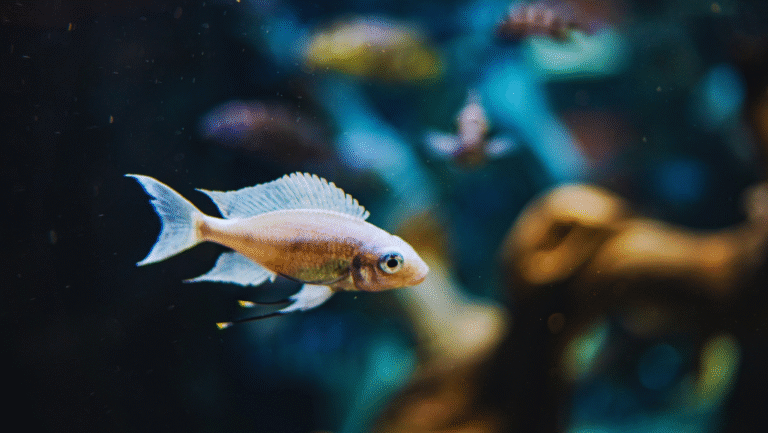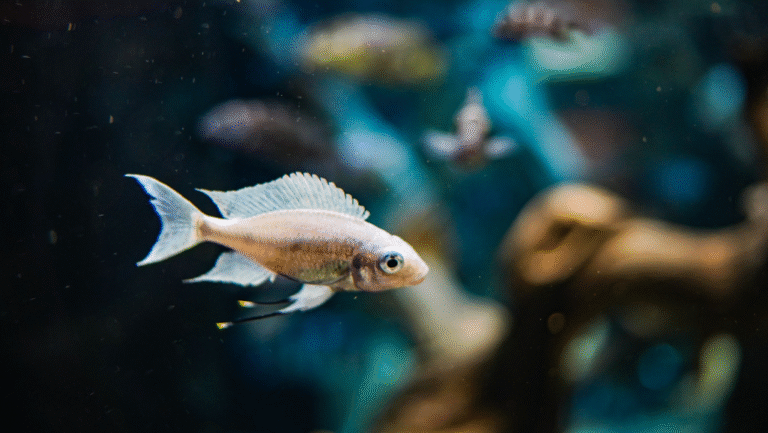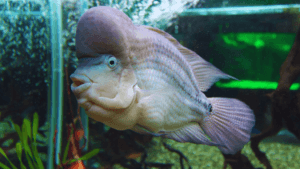Welcome to the world of fishkeeping, a journey filled with the beauty of aquatic life. Our is here to help you start your aquarium adventure. With patience and determination, anyone can enjoy this hobby. We make it easy to understand the basics of balancing a mini ecosystem.
Our guide celebrates the variety of nature, offering many ways to keep your aquarium thriving. This journey needs respect for aquatic life and a bit of creativity. It’s important to use a conditioner in tap water and choose larger aquariums for beginners. Join us as we show you how to create a thriving underwater world.
Key Takeaways
- beginner aquarium basics.
- Larger aquariums offer more stability to beginners, thus making them a wise choice for newcomers in the hobby.
- Efficient filtration is key, with recommendations suggesting a filter turnover of 3-5 times the aquarium volume every hour.
- Ensure all chlorinated water is treated with a de-chlorinator to create a safe environment for your fish.
- Dual heaters, such as the recommended EHEIM Jager, provide consistent temperatures essential for most aquatic inhabitants.
- Adopting a proper feeding routine with at least two meals a day can significantly benefit your fish’s health.
- Investing in a quality water test kit will keep crucial water parameters like pH, ammonia, nitrite, and nitrate levels in check.
- Utilize maintenance tools such as the Python No Spill Vacuum to facilitate a clean and healthy aquarium ecosystem.
Understanding the Aquatic Ecosystem
An aquarium that’s well-kept is like a mini version of our oceans and lakes. It’s all about the balance between different parts for a healthy life. Keeping the water clear and good for fish is key. We’ll look at how to keep this balance, focusing on good bacteria and regular tank care.
Creating a Balanced Environment
Keeping the water quality right starts with knowing how fish, plants, and tiny creatures work together. For newbies, a simple rule is to have one inch of fish for every gallon of water. But, it’s also important to think about the surface area.
Each tank type has its own needs. Long tanks help with gas exchange, making the water healthier. But, tanks that are shaped like hexagons or bubbles might make it harder to keep the water clean.
The Role of Beneficial Bacteria in Fish Tanks
Knowing about the nitrogen cycle is crucial for fish tank care. Good bacteria like Nitrosomonas and Nitrosospira turn bad stuff from fish waste into something safer. This is how we keep the water quality up.
To keep your tank healthy, you need a good biological filter and enough oxygen for the bacteria. It takes a few weeks for the tank to get stable. Using special products with good bacteria can speed things up. Choosing the right fish and plants helps too, keeping the water balanced.
The main goal is to make a tank that’s like a mini ocean. With the right care and knowledge, your tank can be a thriving home for fish and plants.
Choosing the Right Aquarium
Starting your underwater adventure means picking the perfect fish tank. It’s not just about a container; it’s about a home for your fish. You have to decide between freshwater vs saltwater aquariums, each with its own charm.
Considering Aquarium Size and Weight
Size and weight are key when setting up your tank. A good rule is to choose a tank that can hold 10 to 12 pounds per gallon. This means a 20-gallon tank will weigh about 200 pounds.
Make sure your tank sits on a strong surface that can handle the weight. For beginners, a tank of 20 to 30 gallons is best. It’s big enough to be interesting but small enough to manage.
Types of Aquariums: Freshwater vs Saltwater
Choosing between freshwater vs saltwater aquariums depends on the fish you want. Freshwater tanks are easier and cheaper, perfect for newbies. They’re home to fish like Goldfish, Guppies, and Bettas.
Saltwater tanks are more vibrant but need more care. They require better water quality and special setup. You’ll need tools like algae scrapers and water testing for any tank.
The fish tank cycling process differs too. Saltwater tanks need more precise water control and cycling. This is to keep sensitive marine life healthy. Always cycle your tank before adding fish for a healthy environment.
In short, your tank choice affects daily care, fish tank cycling, and the fish you can keep. Bigger tanks are more stable and offer more fish options. So, think carefully about what you want in your underwater world.
Essential Aquarium Equipment
Starting an aquarium journey means knowing the key equipment. It’s vital to pick the right gear for your fish’s health. This ensures a thriving aquatic environment.
Filtration Systems and Their Importance
Filtration systems are crucial for any aquarium. They offer three-stage filtration: mechanical, chemical, and biological. Each stage is important for clean water and healthy fish.
Mechanical filtration clears debris. Chemical filtration removes bad smells and chemicals. Biological filtration handles ammonia and nitrites, which harm fish. For a 20-gallon tank, a filter that moves 60-100 gallons per hour is best.
To learn more about setting up your aquarium, check out these supplies.
Heaters and Temperature Control
Keeping water temperatures stable is key for fish health. Aquarium heaters are essential. Aim for 3 to 5 watts per gallon to keep water between 74 to 77 degrees Fahrenheit.
Using a digital thermometer and heater controller helps keep temperatures right. These essential aquarium equipment items improve your fish’s health and your enjoyment of keeping them. For more on aquarium care, visit this site.
| Equipment Type | Recommended Specification | Importance |
|---|---|---|
| Filtration | 60-100 gph for 20-gallon tanks | Keeps water clean and supports biological processes |
| Heating | 3-5 watts per gallon | Maintains stable temperatures crucial for fish health |
| Thermometer and Controller | Digital for accuracy | Ensures precise temperature monitoring |
Setting Up Your Aquarium
Starting a fish tank is both rewarding and complex. To help you set up your tank well, following detailed fish tank setup instructions is key. Here’s a guide with important stats and beginner fishkeeping tips to make the setup easy.
| Category | Recommendation | Details |
|---|---|---|
| Cost | Initial Setup | $200 or more for brand-new supplies |
| Size | 10-gallon tank (minimum) | Larger tanks preferred to dilute waste |
| Sales | Periodic Discounts | $1 per gallon sales, 3-4 times a year |
| Heater | 5 watts per gallon | Adjust based on environment |
| Filter Type | Sponge Filter | Ideal for beginners; easy maintenance |
| Lighting | LED with Timer | Essential for plant growth |
| Substrate | Rinse Thoroughly | Avoids cloudy water; use inert substrates like gravel or coarse sand |
| Water Quality | Dechlorinator and Test Strips | Ensure water is safe and balanced |
| Maintenance | Aquarium Siphon | Vital for cleaning and waste removal |
When starting a fish tank, set it up and let it run for 24 hours before adding fish. This step makes sure everything works right and the tank is ready for your fish.
The Basics of Aquarium Decoration
Setting up an aquarium is exciting and rewarding. It brings beauty and calmness. Good decoration is key for looks and fish health. Let’s look at the basics to make a beautiful and useful aquarium.
Aquascaping for Beginners
Aquascaping is like art, using aquarium decoration ideas like substrates and aquatic plants for beginners. Beginners should start simple and choose easy plants. The right substrate is important for plants and good bacteria.
Choosing Substrates and Decorative Elements
Choosing substrates is a big decision. Gravel is popular for its looks and support for bacteria. Sand is good for a natural look and for fish that live on the bottom. Decorative rocks and driftwood add to the look and help fish feel at home.
| Decoration Type | Material | Benefits | Considerations |
|---|---|---|---|
| Substrate | Gravel, Sand | Supports beneficial bacteria, aesthetic appeal | Choose size appropriate for fish and plants |
| Rocks | Lava Rock, River Rock, Slate | Natural look, aids in pH balance | Must be pre-treated if necessary |
| Driftwood | Natural, Artificial | Adds character, beneficial for some fish | Should be cured to prevent tannin release |
| Plants | Live, Artificial | Enhances beauty, provides shelter | Choose species based on care level and light requirements |
| Ornaments | Ceramic, Resin | Visual appeal, provides hiding spots | Ensure non-toxic and safe for aquatic environment |
For more tips on starting your aquarium, check out this beginner’s guide. Remember, the goal of aquarium aquascaping is to create a home for your fish, not just to decorate.
Aquarium Basics: Water Quality and Parameters
Keeping the water in an aquarium just right is key for the health of the fish and other sea creatures. It’s important to know how different aquarium water parameters work together. This knowledge helps create a thriving underwater world.
Understanding pH, Ammonia, Nitrite, and Nitrate
Important water qualities include pH, ammonia, nitrite, and nitrate. The pH level shows if the water is too acidic or too alkaline. This can affect fish health and the tank’s biological processes.
Ammonia and nitrites should be zero because they can harm fish even at small amounts. Nitrates are less harmful but should also be kept low. This prevents algae from growing and keeps the tank healthy.
How to Maintain Optimal Water Conditions
Maintaining optimal water conditions is more than just testing the water. It also means adjusting the water to fit the needs of the fish and other sea creatures. Using the right methods and tools for the fish tank cycling process is crucial for a successful aquarium.
Regular water changes, good filtration, and constant monitoring are important. These are key aquarium care tips for keeping the water just right.
| Parameter | Desired Range – Freshwater | Desired Range – Saltwater |
|---|---|---|
| Ammonia (ppm) | 0.0 | 0.0 (Undetectable) |
| Nitrite (ppm) | 0.0 | 0.0 (Undetectable) |
| Nitrate (ppm) | 0.25 (Average on coral reefs) | |
| pH | 6.5 – 7.5 (Varies by setup) | 8.1 – 8.4 |
| General Hardness (GH) | 4 – 12 dGH | N/A |
| Alkalinity (KH) | 4 – 8 dKH | 8 – 12 dKH |
| Temperature (°F) | 72 – 82 | 72 – 78 (Recommended for marine) |
Keeping a healthy aquarium is a big job. It requires understanding and managing many factors that affect water quality. By keeping the water parameters in their best ranges and sticking to a maintenance routine, aquarium lovers can create a stable and healthy home for their fish and other sea creatures.
The Fish Tank Cycling Process Explained
Understanding the fish tank cycling process is key for a healthy aquarium. It helps create a colony of beneficial bacteria. These bacteria turn harmful ammonia and nitrite into safe nitrate. This makes your tank a stable home for fish and plants.
Steps to Establish Beneficial Bacteria
The aquarium cycling process is the start of a healthy tank. It lets beneficial bacteria grow. These tiny helpers turn toxic ammonia into safer compounds.
This phase lasts four to eight weeks. You need to watch the water closely. Test for ammonia, nitrite, and nitrate often. This ensures the water is safe for your fish and plants.
Cycling With or Without Fish
It’s possible to cycle a tank with fish, but it’s not recommended. It can stress and harm the fish. Instead, use fishless cycling.
Add ammonia sources like food pellets or special products. This helps beneficial bacteria grow without harming fish.
In conclusion, patience and careful monitoring are crucial during cycling. Tank maintenance tips like cleaning and proper filtration are also important. With the right knowledge and tools, your aquarium will thrive.
Choosing Fish and Aquatic Plants
Setting up a freshwater aquarium setup means picking the right fish and plants. This balance is key for a healthy and beautiful aquarium. It keeps the water clean and the fish happy.
For beginners, a 10-gallon tank is a good start. It’s perfect for small fish like neon tetras or guppies. This size tank helps fish act naturally and school together.
Fish waste helps plants grow, which cleans the water. This is why picking the right fish and plants is so important.
Here are some fish care instructions: Keep the water soft and the pH right for most fish (6.5 to 7.8). Adjust the water to match Suffolk County’s for your fish’s health.
| Fish Tank Size (Gallons) | Recommended For | Important Considerations |
|---|---|---|
| 5-10 | Small school fish, few aquatic plants | Ideal for beginners, manageable maintenance |
| 11-20 | About half a dozen small fish | Suitable for exploring varied species |
| 21-40 | 6-12 small to medium fish | Great for advanced plant arrangements |
| Over 90 | Large communities, advanced aquascaping | Needs sturdy stand and extensive care |
Knowing the tank size and fish impact is crucial. Larger tanks offer more complexity but need more care. Use the right water and add trace minerals for fish and plant health.
Plants like java moss and anubias are great for beginners. They’re easy to care for and make the tank look beautiful.
Regular maintenance and monitoring are key, as Island Fish & Reef suggests. Adjusting to Suffolk County’s water and testing regularly helps your aquarium thrive.
By balancing these elements and learning more about aquatic plant care, your aquarium will flourish. It will become a stunning centerpiece in your home.
Aquarium Maintenance Tips
Keeping an aquarium clean is key to its health. A clean tank means happy fish and a beautiful setup. Regular care keeps your fish healthy and your tank looking great.
Regular Cleaning and Water Changes
Start with regular water changes. Experts say to change 10% weekly and 25% monthly. This keeps nutrients balanced and prevents harmful buildup.
Also, clean the tank’s outer surfaces and scrape algae from the glass. Rinse live plants to remove dirt. These steps keep your tank looking good and healthy.
Filter and Equipment Maintenance
Keeping your equipment in good shape is vital. Check and clean your filter often. Replace mechanical filter media every year or two.
Heaters are also important. They keep the water at a stable temperature. Without it, your fish might get sick.
Having the right tools makes maintenance easier. You’ll need buckets, siphons, water conditioners, and more. These tools help you clean faster, so you can enjoy your tank more.
Aquarium maintenance tips keep your fish healthy and prevent disease. Regular water tests and monitoring keep your tank stable. This is good for your fish’s growth and health.
Maintaining an aquarium is a big job but it’s worth it. These tips will help you keep your tank healthy and beautiful for years.
Feeding Your Fish: Best Practices
Feeding your fish right is key to their health. It’s not just about giving them food. It’s about knowing their fish diet and nutrition needs and avoiding overfeeding to keep them healthy. A good feeding routine keeps your fish healthy and your tank balanced.
Understanding Fish Diet and Nutrition
Different fish have different food needs. Herbivores eat a lot of veggies and algae, while carnivores love meat like shrimp. Omnivores need a mix of both. Knowing what your fish needs helps them stay healthy and grow well.
Avoiding Overfeeding and Its Impacts
Overfeeding is a big mistake for new fish owners. Too much food can make the water dirty and harm your fish. Feed adults once a day and young ones a few times with small amounts. Watch how fast they eat to avoid waste.
It’s important to find the right amount and timing for feeding. Being careful with food helps keep your fish healthy and your tank clean. This way, you avoid problems and keep your aquarium looking great.
Common Issues and Solutions in Fishkeeping
Dealing with tropical fish care means tackling common aquarium issues like algae and fish diseases. Knowing the causes and treatments helps keep your aquarium healthy and beautiful.
Identifying and Treating Common Diseases
Early detection and correct diagnosis are key to treating fish diseases. Signs like lethargy or sores can mean diseases like ich or fungus. Treatments like Acriflavine for ich and Malachite green for ich and fungus are effective.
It’s important to use aquarium-specific treatments and follow the instructions carefully.
Preventing Algal Overgrowth
Preventing algae is vital for clear, healthy water. Algae blooms happen with too many nutrients or too much light. To stop this, do regular water changes, control light, and check nutrient levels.
For quick fixes, algaecides can help. But solving the root cause is better for the long run.
By using these methods, you can create a vibrant, healthy space for your fish and enjoy a stunning aquarium.
Conclusion
Starting your aquarium journey is exciting and complex. We’ve looked at the basics of aquarium care for beginners. It’s clear that keeping a healthy aquarium is both an art and a science.
The aquarium hobby is popular in the United States. It attracts millions of people. Whether you have one or many tanks, the love for it is strong.
Fishkeeping offers many experiences. You learn about the balance of your aquarium and choosing fish. Every step, from cycling to daily care, is important for your aquarium’s health.
We’ve covered many topics, from filtration to fish health. This guide is for both new and experienced fishkeepers. It shows the community’s dedication to making aquarium care easy to understand.
As you dive into fishkeeping, remember the scientific advice you’ve received. There are many resources available, from beginner lists to scholarly articles. This ensures you can find reliable answers to any questions.
By joining the aquarium community, you become part of a vibrant group. Your journey to create an underwater sanctuary will enrich your life and the ecosystem you build.
